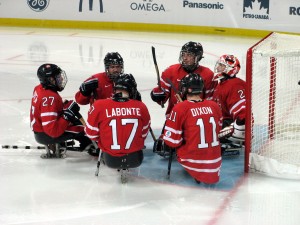ìºë‚˜ë‹¤ëŠ” ì˜ì–´ê¶Œ: ì°ë§¤ 대. ì°ë§¤
 ì–´ì œ, when I attended the Canada-Sweden sledge hockey game during the ë°´ì¿ ë²„ 2010 ìž¥ì• ì¸ ì˜¬ë¦¼í”½, I got to wondering about the word “ì°ë§¤.”
ì–´ì œ, when I attended the Canada-Sweden sledge hockey game during the ë°´ì¿ ë²„ 2010 ìž¥ì• ì¸ ì˜¬ë¦¼í”½, I got to wondering about the word “ì°ë§¤.”
미êµì—ì„œ, 우리가 있었 추ì , but until I came to Canada, I wasn’t familiar with the term “sledge.”
ê·¸ê²ƒì€ ë°í˜€ ê·¸ U.S. stands alone on the sled question, 하키가 ìš°ë ¤ë˜ëŠ” 최소한 ì–´ë””ì—.
ìž¥ì• ì¸ ìŠ¤í¬ì¸ ê°€ 호출ë˜ëŠ” ë™ì•ˆ “sled hockey” in the United States, it’s known as ì°ë§¤ 하키 in the rest of the world.
1960 년대 스웨ë´ì—ì„œ 발명, ì–¼ìŒ ì°ë§¤ 하키ì—ì„œ ìžì‚¬ ìž¥ì• ì¸ì˜ ë°ë·” 1994 Lillehammerì—ì„œ ë™ê³„ 올림픽.
Sledge hockey players sit on sledges (ë˜ëŠ” sleds) with two blades and hold double-ended sticks in each hand. They use the sharp end of the stick to propel themselves across the ice, while the curved edge — resembling a traditional hockey stick — is used for passing and shooting the puck.
그런ë°, Swedesì€ ê²Œìž„ì„ ë°œëª…í–ˆì„ ìˆ˜ë„ ìžˆì§€ë§Œ, yesterday Canada won, 10-1.
모ë‘를 위해 ìž¥ì• ì¸ ì–¼ìŒ ì°ë§¤ 하키 뉴스, 방문 Vancouver2010.com.
ê·¸ë¦¬ê³ ë” ë§Žì€ì— 대한 speaking Canadian English, 우리를 참조 “ìºë‚˜ë‹¤ ë§í•˜ê¸°” 게시물 여기ì—, 여기ì—, ë° ì—¬ê¸°ì—.
사진보기 © 앨런 앨버트




















